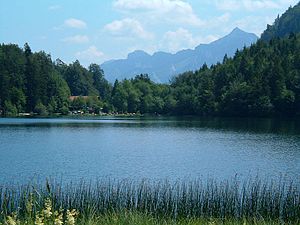Alatsee
| Alatsee | ||
|---|---|---|

|
||
| Alatsee with Vilser Alps | ||
| Geographical location | Ostallgäu | |
| Tributaries | Groundwater | |
| Drain | Faulenbach | |
| Location close to the shore | Füssen , Bad Faulenbach | |
| Data | ||
| Coordinates | 47 ° 33 '39 " N , 10 ° 38' 22" E | |
|
|
||
| Altitude above sea level | 868 m above sea level NN | |
| surface | 12 ha | |
| length | 490 m | |
| width | 290 m | |
| volume | 1,840,000 m³ | |
| scope | 1.3 km | |
| Maximum depth | 32.1 m | |
| Middle deep | 15.3 m | |
|
particularities |
||

|
||
| View over the Alatsee in east direction | ||
The Alatsee is a meromictic lake six kilometers west of Füssen in Bavaria. It is located in a gorge-like depression only about 80 meters north of the Falkenstein ridge with the border with Austria and a good 500 meters south of the deeper Weissensee . It is separated from this by the Untere Weißenseeberg and the Burkenbichlberg. It is 490 meters long (east-west) and up to 290 meters wide. Its area measures twelve hectares and it is a maximum of 32.1 meters deep. The lake is fed by groundwater that flows east over the Faulenbach through Obersee and Mittersee into the Lech .
The lake is located in the landscape protection area protection of landscape parts in the area of the Faulenbacher valley, the Lech valley, the Schwansee valley and the alpine lake area in the district of Füssen (LSG-00078.01).
Ecosystem
At a depth of 15 to 18 meters, the Alatsee has a bright red layer of purple-sulfur bacteria . Above the lake is rich in oxygen, below it is almost oxygen-free.
Despite the lack of oxygen and the toxic metabolic products of the purple-sulfur bacteria, it was repeatedly observed that fish went directly into the layer or emerged from it apparently unharmed. Organisms that require oxygen, such as freshwater polyps , were also found in it, as well as colonies of different types of bacteria that cannot coexist under normal conditions. Different types of insect larvae can also survive in the sulphurous layer or in the sulphurous mud.
The outflow of the lake, the so-called Faulenbach , has an increased concentration of hydrogen sulfide, which can be recognized immediately by the smell.
history
A Celtic place of worship near the lake has been proven.
Up until the end of the 19th century , gypsum was mined in the immediate vicinity of the lake . However, the area around the lake itself was never settled, on the contrary, the locals avoided it until modern times.
Second World War
Air force technicians carried out aerodynamics tests on and in the Alatsee during the Second World War with underwater models of the Focke-Wulf Ta 154 . In the lake you can still find large iron bars and frames that were used for this.
In the 1950s and 1960s in particular, these rumors attracted numerous treasure hunters and divers, who hid much illegally, mainly sunk weapons from the Second World War. However, no treasure or other riches were found. The lake is closed for diving today. Special permits are granted for scientific purposes.
Myths
There are many regional myths and legends about the Alatsee . Mythical creatures are said to live there and to bypass ghosts . Careless hikers would be drawn into the lake and lured into crevices.
Since large numbers of fish repeatedly died and people repeatedly disappeared, the lake is still a notorious place among the local population. However, these deaths are most likely due to the release of hydrogen sulfide.
The local population says that it is possible to get to Austria through cracks in the area around the lake.
Due to the location of the lake in a narrow gorge, there are often strong wind currents that lead to overgrowth and crippling of trees. This is interpreted by esoterics as a sign of existing lines and fields of force.
According to rumors, gold treasures from the Deutsche Reichsbank , which had previously been stored at Neuschwanstein Castle , were sunk on the bottom of the Alatsee towards the end of the Second World War . These rumors as well as the military-technical attempts have inspired the team of authors Michael Kobr and Volker Klüpfel for their Allgäu crime thriller Seegrund in the series Kommissar Kluftinger .

